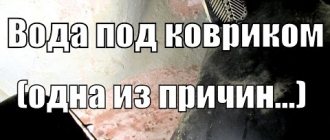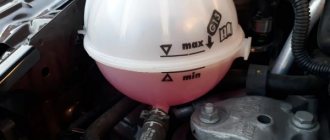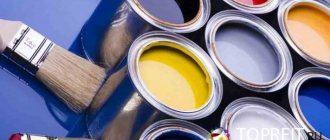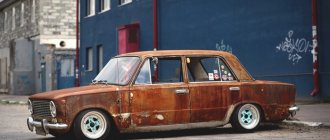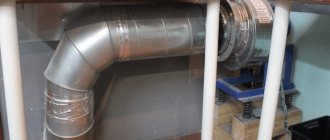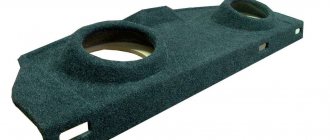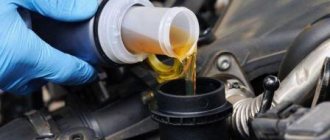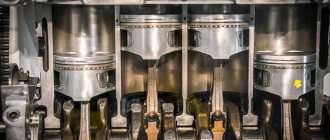Defects in car paintwork
Painting and subsequent varnishing of a car may not always work out. This process requires maximum concentration from the person performing the work, adherence to technology and the use of decent quality materials. But even professional work is not without unpleasant surprises. Moreover, it is much easier to prevent various kinds of errors than to remove them later.
One of the common defects is smudges - drop-shaped formations that appear on the body.
Main causes:
- Unfavorable external conditions. Varnishing can take place in a cold structure or with cold materials. Therefore, it is necessary to warm up the room and the car itself.
- Features of materials. The use of varnish and thinner must be in the correct proportion. They must also be suitable for each other, so it is better to use paints and varnishes from the same manufacturer.
- Inaccurate spray adjustment. The enamel must be fed through a well-functioning small hole in the spray gun, maintaining an angle of 90 degrees. If you use a large nozzle, the varnish will flow rather than spray, and droplets will remain on the body.
- Insufficient degreasing of the car before applying enamel.
Incorrect positioning of the spray gun is the cause of smudges
Elimination of varnishing errors
There are several ways to remove smudges.
The first method is “washing out”. You will need putty, fine sandpaper (P2500 and P2000), water and a vacuum cleaner. The car surface to be treated is first thoroughly dried (an industrial hair dryer or spotlight can speed up the process). Then putty is applied to the stains - it will protect the varnish from damage.
The putty layer is watered and then carefully polished with sandpaper (P2500). By the way, if you wrap it around an even block and make short movements, the polishing will be done more accurately. After reaching the thickness of the putty layer, you should take a finer sandpaper (P2000) and treat the surface with it until the putty disappears. After this, polishing is completed with P2500 sandpaper. At the end of the work, you need to remove the dust with a vacuum cleaner and (if desired) re-coat the sanded fragment with a layer of varnish.
The second method is “washing out” with a marker. You will need a marker, fine sandpaper, water and a vacuum cleaner. This method is similar to the first, the only difference is that the marker replaces the putty. By drawing lines with a marker on the smudges, you can see how deep the polishing goes.
The third method is scraping. You will need masking tape, a construction knife, a rubber block, several types of sandpaper P600-P2500, soap, water. The area where the car is sagging is covered with masking tape. It is needed so as not to damage the clean surface. The smudges themselves should not be soft. Just in case, you can dry them.
Removal of smudges is done with a knife blade - they are carefully scraped off from top to bottom. Then, with a rubber block wrapped in coarse sandpaper and soaked in a soap solution, those places on the car where the varnish was scraped off are sanded. Gradually, the sandpaper needs to be changed to a finer one, ending at P2500.
The fourth method is removal with a cutter. Its main purpose is to remove dust, but it also copes well with influx. The cutter should be held at an angle of no more than 40 degrees. After treatment, the leak area is carefully sanded.
Thus, even with simple improvised means you can remove defects in car varnishing. The main thing is attentiveness and accuracy.
How to pay TWICE LESS for GASOLINE
- Gasoline prices are rising every day, and the car's appetite is only increasing.
- You would be happy to cut costs, but is it possible to live without a car these days!?
Eliminating smudges on hardened paint
In this case, unfortunately, you will have to put in more effort than in the previous one. If you find a smudge on hardened paint, do not panic; it can be removed without completely repainting a certain element.
Important! If the paint has not yet completely hardened, but is already close to it (that is, it will not spread on its own if tilted correctly), do nothing! Let it cool completely! Otherwise, you risk removing several layers of paintwork at once, and then you will probably have to repaint everything again.
Elimination of such “errors” should be done in the following order:
- First, mark the boundaries of the defect (so that during subsequent work you do not “do extra work”).
- Use a blade to cut off the leak. Let us remind you that you need to do this work as carefully as possible (try to feel like a jeweler at this moment). Start removing drops from the top, slowly moving down.
- The third stage is the skin (by the way, it can also be the second, but only if the defect is very small). So, install a P800 sandpaper on the grinding machine, using a special cream (sometimes it is replaced with plain water). The closer you come to “victory”, the end of the work, the more often you replace the skin with a softer one. The work should be completed with P200. Be especially careful, do not rush and remember that it is much better not to rub it in than vice versa.
- Polishing is carried out precisely at this stage. But at the same time, constantly move the grinder, never staying in one place.
Body polishing is a cosmetic operation for a car.
First, let's look at the simplest case, when the scratches are very small and insignificant, damaging only the top layer of paint. As a rule, these damages can result from contact with pebbles or small branches.
In this case, you just need to properly polish the damaged area. Based on the tasks to be solved and the functions performed, there are two main types of cosmetic polishing of the machine:
- Abrasive polishing is the simplest method aimed not only at restoring the body, but also giving it its original beautiful appearance. The polish itself is of great importance, because preference should be given only to high-quality products. Otherwise, you can neutralize both the scratches themselves and the protective layer of paint. If you polish your car too much, you will have to perform more complex restoration work.
- Protective polishing - unlike cosmetic polishing, this category of work is aimed exclusively at restoring the paint layer of the car body. In addition to standard polishes and similar compounds, numerous mastics and special car waxes can be added here. The principle of operation of such compositions is that after application to the surface of the car, a film is formed that corrects damage, while perfectly masking it.
Polishing is carried out after applying polish to the body. Specialists usually use special equipment, for example, a grinding machine or similar equipment. But you can completely do without these devices by using fine-grained sandpaper or even a usually thick napkin if the scratch is very small and unnoticeable.
After applying the composition to the metal, you need to grind the surface using gentle circular movements. The paste must be constantly moistened, since a dry composition when rubbed into the top layer can cause additional damage. Once there is no trace left of the scratch, polishing can be completed. These actions must be performed only in warm, dry rooms where there is no exposure to external factors, including moisture, precipitation or dust.
Removing small stains
They are much easier to remove. If the defect appeared a few minutes ago, you can simply lift or unfold the part - the enamel will evenly spread over the surface on its own. But if the defect is not completely eliminated in this way, but only partially, you can add another layer of enamel.
How to remove paint smudges if the surface has hardened? If a small drop of paint has already dried, you can use sandpaper. It is better to start with P1500 material and finish with fine-grained P2500.
How to remove varnish stains on a car after painting (step-by-step instructions with photos and videos)?
Good afternoon. From today's post you will learn how to remove varnish stains on a car after painting.
It's no secret that Russians' incomes are not as high as they would like and the vast majority of the population drive cars older than 10 years. Naturally, such a long period of time negatively affects the appearance of the car, and most car owners end up repainting their cars, and since painting a car is quite expensive, many do it themselves. In this case, with a high probability the following smudges are obtained:
And if there is a smudge on metallic (base enamel) it is impossible to remove! Either on acrylic paint or acrylic varnish, the smudge can be removed without major problems, you just need to be careful and patient.
So, in order to remove smudges on acrylic varnish, we will need:
- Sandpaper 240-360-400-500-600-800-1000-1500-2000
- Soft rubber block
- Water
- Polishing paste 1 and 2 numbers
You may need:
Blade for smudges - will speed up the work and allow you not to sand off the smudge itself
Universal putty. – allows you to sharpen smudges without fear of opening the varnish.
Step-by-step instructions if you don’t have a blade to cut off smudges:
Step 1 - sand off the leak itself. Sandpaper with numbers 240-360-400-500-600-800-1000-1500
We work with sandpaper with numbers after 800 with water, and rub the smudge crosswise on a soft rubber block.
Here's a short video for you:
Step 2 - after the smudge is leveled with the rest of the varnish/paint surface, be sure to wash the surface.
Step 3 – polish with paste numbers 1 and 2, making sure to wash the polishing area after each number.
Here's an example in the video:
Step 4 – wash the repair area and enjoy the result (scratches are a consequence of haste).
Notes.
If you have a smudge remover blade, which you can buy here, the process will speed up.
Cut off the smudge with a blade, matte the surface with a rubber block using sandpaper with numbers 400-500-600-800-1000-1500 and then wash and polish according to the instructions.
If there is a very thin layer of varnish at the site of the smudge, or if you have never sanded off smudges before, use putty.
The technique is as follows - apply the putty in an even layer to the area of the leak:
And sand it as in normal preparation for painting.
Your task is to sand the putty, finishing sanding at number 800-1000, in this case the drip will go away and the varnish next to it will not come off.
When the putty is sanded, knock down the marks from 1000-1500 sandpaper with water and polish the area of the leak.
That's all for me today. I hope that the article fully answered the question of how to remove varnish stains on a car after painting?
If you want to add to the article or have any questions, write comments.
DIMMYANTUS › Blog › How to properly remove smudges of car paint on the body
When painting a car, large and small smudges sometimes form. Fortunately, both of them can be eliminated completely - how this is done will be discussed further...
Large leaks and difficulties in eliminating them
No one is safe from car paint smudges. However, as a rule, large smudges are typical for novice craftsmen: moreover, painting a car with your own hands without many years of experience is very often accompanied by smudges. Therefore, it is important to learn not only how to paint perfectly, but also how to remove smudges if they form. What is needed for this?
Sandpaper: R-600, R-1000, R-1500, R-2500;
Rubber or silicone block;
Regular car wiper;
Soap or soapy water;
To successfully remove a smudge, it must be dried. If the paint does not dry, there is a high probability of the smudge coming off and trapping the deeper layers. The main problem with large leaks is that it takes a lot of effort to eliminate them, and at the very end there may be a surprise: miniature shells and bubbles may remain in place of the eliminated leak.
So, in order to remove a large smudge, it is necessary, if possible, to cut off its protruding part with a blade (especially droplets). Then wrap the block in P-600 sandpaper, dip it in soapy water (soapy water provides gliding and prevents paint from coming off) and sand the rest. When the edges of the smudge begin to rub off, you can switch to finer sandpaper R-1000, then to R-1500, and finally go through R-2500, so that you can polish the car with your own hands as quickly as possible.
For comparison, you can try the second option (it works well even if the smudge has not completely dried). The idea is to putty the stains with a thin layer of universal putty. Then let it dry for 10-15 minutes and start sanding as described above. It is important to remember that the more the putty dries, the more difficult it will be to wash off, so you need to hurry. After about 45 minutes, it will already become stronger in structure than paint, and it will begin to rub off on the sides right down to the ground.
How to remove paint smudges if they are minimal?
With small smudges everything is much simpler. If the leak was made a few minutes ago, you can simply unfold or lift the part so that it spreads completely. If the smudge does not completely disappear within a few hours, then you can add another layer of paint to completely hide the defect.
A small dried smudge can be removed in the same way as a large one, but you can start with R-1500 sandpaper and finish with R-2500
How to remove smudges on primer?
Preparing a car for painting is not always successful, because smudges can appear on the primer if it is diluted too thinly. If this happens, then do not rush to get upset, since the primer is rubbed off even easier than paint. Since the primer is rougher, it is better to use R-240 and R-400 sandpaper for grouting.
To avoid smudges when completely painting the body, it is advisable to follow the correct order of painting the car.
The technology for painting a car involves painting it without any defects, but, unfortunately, it is not always possible to do everything according to the technology. For example, painting a car with a transition is not easy for most craftsmen. That is why, when distilled with a solvent for transition, small smudges remain in the middle of the part. At first glance, everything looks terrible, but once they are rubbed with R-2000 sandpaper and polished, the surface becomes flawless.
Polishing a car after painting the body
Polishing a car after painting
After polishing the car, to maintain the shine and good appearance after painting the car for a long time, you need to polish the car body. Polishing a car body is designed to give the car an excellent appearance, eliminate microcracks, scratches, remove the smallest unevenness in the coating and protect the coating from external factors. Since the smallest paint defects, invisible to the naked eye, allow aggressive liquids to penetrate under the coating and cause corrosion, polishing also protects the body from these processes. Polishing stages:
- partial removal of the coating, in which fine abrasive sandpaper is used;
- restorative polishing using abrasive paste;
- protective polishing after painting the car with a non-abrasive paste to give a special shine.
Types of polishes
- If the paint on the body is not badly damaged, then it is enough to use a polish without abrasive particles to restore it, but before that you need to treat it with a polish with a high content of abrasive elements.
- If there are a large number of microcracks on the body, it is better to use color-enriching polishes. Which cannot replace paint and eliminate scratches to metal, and they do not form a protective coating on the body, so they should be used in combination with protective types of polishes.
Classification of polishes by consistency:
- paste polishes. They are used for horizontal and vertical surfaces due to their thick consistency. At the same time, they give the coating a significant depth of color;
- Liquid polishes are safer to use because they do not cause increased wear of the coating even with prolonged use. But they are limited in scope and are used only on horizontal surfaces;
- Although aerosol polishes are convenient to use, due to the fact that a significant part of the can is occupied by solvent and propellant, the amount of polish itself in it is not very large.
Depending on the depth of damage to the body coating after painting a car, polishing is divided into restorative and protective.
Car polishes
Restorative polishing can be used to remove shallow scratches, the depth of which does not exceed the depth of the paintwork before the primer; tearing out abrasions and oxidized layers, which manifest themselves as clouding of the paintwork, in the form of spots or stripes. The process of applying restorative polishing consists of mechanically removing a surface layer with abrasive pastes about 5 microns thick. Whereas the thickness of the paint coating is about 100-150 microns, therefore about 10-20 polishings can be carried out on one painting without compromising its integrity. Protective polishing is designed to protect the paintwork after painting a car from negative environmental influences. It uses non-abrasive polishes based on wax or synthetic materials. Depending on the bases on which polishes are made, they are divided into wax, silicone and polymer. Wax and silicone protective polishes are easy to apply, but also easy to wash off after two or three visits to the sink. And they will need to be reapplied. Polymer polishes are more durable; they are applied once every 6 months, have good protective properties, but at the same time they are more expensive and their application is more labor-intensive. If you painted your car metallic or pearlescent, then you need to buy polishes specifically for these types of coatings.
The main reasons for the formation of smudges
After painting body parts, smudges may form on the paintwork, which are considered defects. There are many reasons for this unpleasant phenomenon, but mostly leaks arise due to the inexperience of the technician. To ensure that the paint is applied to body parts evenly and does not run off, certain rules must be followed:
- the paint must be applied in a layer of a certain thickness;
- solvent and paint should be mixed in the required proportion;
- the spray gun must be kept at some distance from the surface to be painted;
- The temperature of the surface of the body or body element should not be low.
There are also a number of rules that must be followed when painting body parts, but if you cannot complete the job without defects, you need to skillfully remove smudges after painting the car.
Removing pollen with an auto scrub
Auto scrub is an alternative to cleaning clay and is produced in different versions - a circle (for working with a polishing machine, as well as manually when using a special holder), a mitten, a towel, a sponge (for working manually). It can have different gradations (aggressiveness of impact). When using an autoscrub for machine processing (Autoscrub Foam Pad), it is recommended to use a dual-action (eccentric) polishing machine, since a rotary machine will be too aggressive on the paintwork.
Auto scrub is used with a lubricant or soap solution.
The close-up photo shows pollination along with traces of water droplets. This contamination occurred when the car was parked close to workers who were painting something. The most damaged part was the trunk lid. The surface was very rough, and the contamination was not washed off.
For cleaning, a medium grade Nanoskin Autoscrub wheel was used on an orbital polisher with a large amount of lubricant (diluted Nanoskin Glide). This is a foam circle combined with a very soft rubber surface. After removing dirt and wiping with microfiber, the surface was polished.
Matte coating
High-quality painting work implies obtaining a glossy shiny surface as a result. The greatest gloss is provided by two-component paints and compounds applied with a spray gun.
The cause of a matte surface may be:
- Uneven coloring;
- Insufficient thickness of paint coating;
- Scratches from smoothing.
To eliminate the defect, repeated smoothing and application of the next layer of painting material are carried out.
[ya_bo]
Why did the paint lift?
- Cheaper paints tend to lift the old coating more often.
- Solvents of applied paint act on the old coating. This is a chemical reaction of the solvent that softens the underlying surface and lifts it. The reason may be that the base paint is applied too thickly. This can happen due to the old coating becoming saturated or getting under its edges or through rubbing marks from sanding. Never apply a thick (wet) first coat. Apply the first layers thin, semi-wet (closer to dry, but too dry layers are also bad, as they will impair the adhesion of subsequent layers). This will reduce the likelihood of paint lifting. The room must be warm enough so that the solvent has time to evaporate before it affects the surface.
- The first layer did not dry properly. In this case, the materials can be of high quality and compatible. Solvents in the paint base affect the applied coating. This leads to wrinkling. If you apply the base to a recently primed and prepared surface and paint lifts, it means that the primer has not dried well enough or is not fully activated. If the sanding paper "clogged" when you prepared the surface for painting, then this is a sign of uncured primer. If a one-component primer was applied, it does not harden, but only dries and solvents from the paint can saturate it.
- Applying layers that are too thick, preventing the bottom layer from evaporating the solvent and drying at the same rate as the top layer.
- The surface may be too hot to coat.
- Improper cleaning and surface preparation. If there are areas on the surface to be painted that are not prepared for painting (unsanded area). It must be remembered that before sanding the old coating must be thoroughly washed, since the protective coating layer or dirt may remain at risk and impair the adhesion of the new paint. Use matting paste, it has both matting and cleansing properties. You can also read the article “preparing the car for painting”.
- Insufficient drying time between coats. The solvent does not have time to evaporate from the first layer. It is important to dry the bottom layer thoroughly before applying the next coat.
- Too much time between layers. There is a period (window) in which you can apply a second coat or repaint a recently painted surface. If this period has passed, a paint “lifting” defect may occur. Typically, the paint should be applied in several thin layers, every 15–20 minutes and no later than 1–2 hours. If this period has passed, then you need to wait a day and prepare the surface again.
- Sometimes, the paint can wrinkle when applied to the bumper. This can happen if there are areas of bare plastic on the bumper. The anti-adhesive lubricant that is used at the factory during their production may remain on the bumper, which will “lift” the paint. Prepare the bumper for painting correctly (see the article preparing the bumper for painting).
- Incompatibility of coatings. Inappropriate base coat (for example, nitrocellulose paint or primer).
When the top layer is quickly dried, a film is formed that prevents the evaporation of the solvent from the bottom layer.
- Incorrect drying. Accelerating the drying of the top layer leads to the fact that the bottom layer remains wet and is sealed by the top one. Do not dry a freshly painted surface with dryers immediately after applying paint. Allow the surface to dry a little on its own, after which you can accelerate hardening.
- If the surface was degreased using a solvent, instead of a special degreaser, this may cause a paint “lifting” reaction. Even if a special product was used, make sure that the degreaser has completely evaporated before applying paint.
Primer Defects: Removal Methods
If the manufacturers' recommendations are not followed, primer paints can also form smudges. If these deposits of primer are significant, then they must be removed, otherwise the unevenness will be noticeable even after applying the top paint coating. Smudges on the primer are eliminated using the same sandpaper of different grain sizes.
Moreover, it is even easier to remove defects with a primer than with paint. After all, minor roughness that may remain after sanding with sandpaper with a grit of P240 to P400 will subsequently be covered with paint. Therefore, you don’t have to waste time on very careful sanding with fine-grained sandpaper (mandatory for the top paint layer). If, after removing the primer drip with a blade, a small cavity forms, then you can not use putty, but simply apply an additional layer of the same primer.
Preparatory work and what is needed for this
It is worth keeping in mind that smudges must be eliminated before applying the finishing coat of paintwork. Before this event, prepare everything you need for work.
What is needed to eliminate smudges
To eliminate smudges on metal and plastic, you need to have the following:
- Masking tape;
- Sandpaper;
- Water;
- Sharp blade;
- A wooden block to wrap the skin;
- Polishing paste and machine;
Removing minor stains
If the paint has leaked just a little, then getting rid of such flaws will be much easier. Especially if only a separate body part is painted. In this case, immediately after smudges are discovered, you can quickly turn the part over so that the paint, which has not yet completely dried, can spread evenly on its own. Very minor smudges can be masked by simply applying another layer of paint.
Work to eliminate paint defects is completed by surface treatment using special polishing pastes.
How to avoid them
Smudges appear on surfaces where several layers are required. The risk increases if a larger area needs to be treated.
When painting furniture
Paint is often used to coat furniture. On the vertical walls of cabinets, the risk of streaks is especially high. The occurrence of smudges on furniture, measures to eliminate the problem:
| Problems | Elimination methods |
| Thick coat of paint | Apply several thin layers at 1 minute intervals. Hold the spray gun, aerosol can or gun at the optimal distance at an angle of 90 degrees. |
| Lack of clutch | Priming and sanding the surface. Use of high-quality compounds for priming. Complete drying of the primer layer. |
| Heavy smudges, liquid paint | You cannot add the entire volume of solvent to the mixture, so as not to make the composition liquid. It is recommended to add it gradually to achieve a suitable consistency. |
When painting a car
Repainting a car depends on the characteristics of the paint composition. It should provide strong adhesion and an even finish.
Possible problems when painting a car, solutions:
Cause of streaks and streaks Possible solution Paint is running due to lack of adhesion Before painting, preparation should be carried out. The surface is treated with a primer that will ensure adhesion. The condition for creating the preparatory layer is the use of a grinding machine or sandpaper. With their help, all visible flaws are removed. Presence of slow thinner, too much thinner The paint is thinned gradually, adding a few milliliters of thinner at a time, so as not to create a liquid mixture that cannot contribute to the formation of the coating. A poor quality thinner does not allow the composition to create the necessary structure. Violation of the rules on maintaining the optimal distance from which paint is applied. Excessive approach or separation creates insufficient or excessive pressure, provides an uneven layer or a layer of incorrect thickness. Thick layer Coatings 2 or 3 times thick create a layer that provokes streaks Spray gun settings are incorrect Factory settings are recommended Temperature discrepancy Cold car does not accept warm paint well
Cold paint does not adhere well to the surface, so it is important to bring both temperatures closer in key indicators.
How to paint correctly
In order not to mess things up, you need to first learn how to paint correctly. Now we will share how acrylic painting works. So, it includes three stages:
- the first of them is applying the base;
- the second and no less important is applying the main one;
- and the final one is protection.
It is important to remember the correct proportions: add more liquid and smudges will form on the surface; make the “mixture” too thick and it will be difficult to spray. In addition, the room should not be too dusty! And the most optimal temperature for carrying out this kind of work should be no less than 19 and no higher than 21 degrees Celsius (otherwise it will take too long to dry, causing smudges to form).
How to remove smudges after painting a car?
Before removing the stain, the paint or varnish must be completely hardened. So that both the leaks and the rest of the paintwork are of the same hardness. Stains take longer to harden than other fresh paint due to their thickness. A smudge that has not completely hardened and the paint or varnish adjacent to it can be sanded differently, which may make it difficult to remove it without leaving a trace. You can check the hardness by scratching the stain with your fingernail. It is better to remove stains after 24 hours of drying or later. This time is enough to harden and the paint remains slightly pliable for sanding.
To remove the bulk of the smudge, you can use replacement blades (for paint scrapers or scrapers for glass ceramics). Use a new blade each time. Hold the blade at a 90-degree angle and scrape along the stain in one direction. There is no need to try to cut off the smudge; scrape off each passage a little. If the leak has hardened well, this method works well. When using the blade, its edges should not touch the paint surface. It is better to seal the edges with masking tape so that only the middle of the blade remains sharp. After scraping off the bulk of the smudge, the remaining unevenness should be sanded using P2000 sanding paper with a hard stone and polished.
The smudge can be removed by sanding paper through a hard block with water, but there is a danger of rubbing off the paintwork adjacent to it. We will look at how to avoid this in the next paragraph. Large smudges can be started by sanding with P800 or even P600 abrasive and continue with P1000 - P2000. Sanding paper P600 can remove 80% of the smudge, and the remaining 20% can be removed with finer abrasives. The function of the hard block is to sand down the high spots of the smudge without touching the surrounding paint surface. Never use a sponge soft block to remove smudges as it will only hug the smudge as you sand. When sanding with water, periodically remove the water and check the result. Why not sand the smudge immediately with P2000 abrasive? If you remove the smudge only with P2000 sanding paper, it is safer, but it will take a lot of time. In addition, when it seems that the smudge has disappeared, after polishing you will be able to see a small unevenness where it was. This is due to the fact that the P2000 abrasive is too fine and does not cut off excess varnish well, but rather smoothes it out. Therefore, it is better to start removing stains with at least P1000 abrasive, continue with P1500, and finally remove scratches from previous abrasives with P2000 paper. It is better to soak the sanding paper in water with a small amount of dishwashing detergent.
Putty can also be used to remove smudges. It is better to use fine finishing putty. It is applied in a thin layer to the stain and the surrounding area. The function of the putty is to prevent rubbing of the paintwork located next to the smudge. The putty should be sanded using P600 sanding paper with a hard block. The smudge will be erased along with the putty. When all the putty and smudges are erased, you need to change the sanding paper to P1500, and then P2000, to remove large marks. Next, the matte paintwork needs to be polished.
When sanding, the smudge is removed along with the putty, and the surrounding varnish remains practically untouched.
Where do leaks most often form?
A phenomenon such as leakage in the form of individual drops or sagging can form anywhere on the part. But most often these are the lower edges of doors and skirts, as well as vertical planes. If the paint is too liquid and is applied in a large layer at a time, then the solvent does not have time to evaporate - as a result, the layer begins to slide off under the influence of gravity.
If smudges do not appear immediately after painting the car, this does not mean that they will not appear in an hour. Sometimes all the bottom edges of parts become wavy due to sagging and drops. But the situation can be corrected by grinding and polishing, although it is better to avoid it.
When buying a car, you must first pay attention to the lower edges. The presence of drops, waviness, and sagging indicates that the painting work was carried out by a low-skilled craftsman. This is a reason to significantly reduce the price. However, it should be taken into account that eliminating such effects is also expensive.
Deterioration of paintwork due to environmental influences
During the operation of the car, its coating is greatly affected by all kinds of insects that break on the hood and other parts of the body. Such impacts leave small spots, then, under the influence of high temperatures and humidity, the dead insect seems to “sink” deep into the car’s coating.
Because of this swelling, the paint begins to deteriorate at an accelerated pace. And although the damage is only a few millimeters in size, it can have a very negative impact on the paintwork. You should try to notice such defects immediately and eliminate them.
To do this, you need to thoroughly wash the vehicle using special shampoos. After it dries, all affected areas are treated with a special liquid to remove adhering insects (you can purchase it at a specialized auto store). Then the surface is thoroughly cleaned with a degreaser and treated with solid mastic.
Some defects can be caused by seemingly harmless bird droppings. The damaged area usually appears duller than the rest of the coating and the area is slightly corroded. It is in hot weather that bird droppings most seriously damage the paint and varnish that covers the car.
If it is not eliminated in time, it can cause chemical burns to the surface, cracks, and the paint layer in this place can be etched down to the putty layer. If the damage to the body is minor, it can be removed by polishing using special pastes and polishes.
On the body you can also see drops of a brown tint from drops of sap or resin dripping from the trees. They have a destructive effect on the paint layer in the warm season; in winter, the resins practically do not destroy the coating. Due to exposure to high temperatures, the resin begins to melt, its components react actively with the enamel that covers the body and this leads to swelling.
You can get rid of swollen areas in a paint drying box. There, using infrared radiation, the ambient temperature is achieved at 60C, then warm up the vehicle for about an hour. You can remove stuck particles of resin from the body using a clean cloth soaked in kerosene (gasoline).
The secretions of aphids can erode the body coating almost down to the putty. Such droplets no larger than 1 mm in size greatly damage the paint layer, so they need to be removed as quickly as possible. Any tarnished paint that remains after this can be removed by thoroughly polishing the car.
After cement gets on the surface of a car in the warm season, it begins to form alkaline compounds that corrode the paint layer. Therefore, you need to immediately wash off the dirt and remove dull spots after them by polishing. If the cement has already dried, you can soften it by applying a napkin soaked in vinegar to it. After this, the cement is carefully removed, the area must be thoroughly rinsed with ordinary running water and polished.
Industrial dust deposits leave defects on the body that differ in color from the rest of the coating (can have all shades from red to blue). If such islands are not removed in time, rust forms in those places, which can rapidly increase in size.
defect in paintwork
Dust that contains iron particles is very difficult to remove from the surface of the body, and if this is not done immediately, after a few days it will become completely impossible. Dust can be removed from the surface during the washing process, then finishing polishing can be done using a cleaning mastic.
Some flaws form even at the time of painting and can become noticeable immediately after drying.
Polishing
After leveling the surface, apply a small layer of 3m polishing paste to the paintwork; it is sold by weight and requires very little to polish. Then we take the sander and start polishing, constantly moving the sander from side to side. Polishing should be carried out evenly, without holding the machine in one place for a long time.
Before polishing, all surfaces of the car body should be covered with a protective layer of special paper, all glass, rubber seals and plastic parts, securing the paper with masking tape. You should also close all emblems and holes in the radiator grille, and it is better to remove the turn signals and mudguards. If possible, the interior and engine compartment should be sealed; it is advisable to prevent dust from polishing from getting there.
GAZ-22 is back in service
After disassembling the car into parts and troubleshooting, welding work was performed. The normal condition of the bottom, sills and boxes has been restored.
After removing the old coating from the bottom and body, as well as replacing the rear wings, the car was covered with primer. The new paint color, a dark gray shade, suited the austere model well. The interior and sofas of the car were completely redesigned.
The old engine was not suitable for long journeys. It was replaced with a powerful engine from a Volvo 940 with a volume of 2.3 liters. The lengthy assembly of the updated Volga has reached its logical conclusion.
Where do the drips come from?
The main reasons that the paint goes on unevenly is non-compliance with the painting rules. And this manifests itself in different ways.
- Failure to follow the instructions for the paint: the proportions of the pigment and solvent are incorrect, or the thinner used does not match the paint. As a result, the composition turned out to be too liquid, and it is not able to stay on the body;
- The spray gun is not adjusted before use;
- The muzzle of the apparatus was held at an angle, or at too great a distance from the surface, or over one area for too long;
- During the work, dust got into the paint;
- The temperature regime was violated when storing the compositions or in the room where painting was carried out;
- The required time interval was not maintained between individual layers, and the previous one did not dry completely before applying the next one;
- Well, and, of course, low-grade paint. Moreover, it does not have to be cheap: you can buy an expensive one, but an unsuccessful one, or a trusted manufacturer, but a fake.
Minor flaws:
Some defects can be corrected either immediately or without additional effort. So, if you are painting a separate element of the body and notice that the paint has flowed, you need to quickly turn it: the composition that has not yet dried will be evenly distributed over the surface.
If drips are detected after drying, but are very small (for example, they are not visually detected, but can be felt), another applied layer of paint can help out. Just this time, try to do everything as correctly as possible.
Let's save the situation
Build-up should be removed only after the applied layer has completely dried. Otherwise, when removing them, the lower layers may be removed, resulting in the formation of deep pockmarks. Or the connection between them will be broken: then over time the paint will begin to peel off and crack.
- Defects on the body that need to be eliminated are delimited from the body by gluing masking tape. These frames are needed so that during the work you do not begin to cover up high-quality painted areas;
- If the drip has formed a thick build-up, it must be cut off with a blade as close to the surface of the body as possible. You need to act extremely carefully so as not to cause scratches. Lumps that are not too protruding can be removed without this step;
- A rather coarse sandpaper (for example, P800) is wrapped around the block, the sandpaper is moistened with water and soap dissolved in it, and the cleaning begins. From time to time, the skin needs to be dipped into the bowl again or the treated area should be sprayed with a solution;
- Gradually, as the thickness of the drip decreases, the skin changes to increasingly fine-grained. Finish the sanding with P2000 sandpaper and finish it with a polishing machine;
- If the build-up is not too rough and the painter is not very confident, the solution can be supplemented with an aerosol sanding detector. Firstly, sanding will proceed more smoothly, and secondly, it will be easier to determine when it is time to finish: there should be no traces of aerosol left on the area being sanded.


